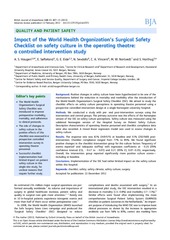| dc.contributor.author | Haugen, Arvid Steinar | en_US |
| dc.contributor.author | Søfteland, Eirik | en_US |
| dc.contributor.author | Eide, Geir Egil | en_US |
| dc.contributor.author | Sevdalis, Nick | en_US |
| dc.contributor.author | Vincent, Charles A. | en_US |
| dc.contributor.author | Nortvedt, Monica Wammen | en_US |
| dc.contributor.author | Harthug, Stig | en_US |
| dc.date.accessioned | 2014-09-17T11:37:12Z | |
| dc.date.available | 2014-09-17T11:37:12Z | |
| dc.date.issued | 2013-05 | eng |
| dc.identifier.issn | 0007-0912 | |
| dc.identifier.uri | https://hdl.handle.net/1956/8500 | |
| dc.description.abstract | Background: Positive changes in safety culture have been hypothesized to be one of the mechanisms behind the reduction in mortality and morbidity after the introduction of the World Health Organization’s Surgical Safety Checklist (SSC). We aimed to study the checklist effects on safety culture perceptions in operating theatre personnel using a prospective controlled intervention design at a single Norwegian university hospital. Methods: We conducted a study with pre- and post-intervention surveys using the intervention and control groups. The primary outcome was the effects of the Norwegian version of the SSC on safety culture perceptions. Safety culture was measured using the validated Norwegian version of the Hospital Survey on Patient Safety Culture. Descriptive characteristics of operating theatre personnel and checklist compliance data were also recorded. A mixed linear regression model was used to assess changes in safety culture. Results: The response rate was 61% (349/575) at baseline and 51% (292/569) postintervention. Checklist compliance ranged from 77% to 85%. We found significant positive changes in the checklist intervention group for the culture factors ‘frequency of events reported’ and ‘adequate staffing’ with regression coefficients at 20.25 [95% confidence interval (CI), 20.47 to 20.07] and 0.21 (95% CI, 0.07–0.35), respectively. Overall, the intervention group reported significantly more positive culture scores— including at baseline. Conclusions. Implementation of the SSC had rather limited impact on the safety culture within this hospital. | en_US |
| dc.language.iso | eng | eng |
| dc.publisher | Oxford University Press on behalf of the British Journal of Anaesthesia | eng |
| dc.relation.ispartof | <a href="http://hdl.handle.net/1956/8502" target="blank">Impact of a surgical safety checklist on safety culture, morbidity, and mortality. A stepped-wedge cluster randomised controlled trial</a> | eng |
| dc.rights | Attribution-NonCommercial CC BY-NC | eng |
| dc.rights.uri | http://creativecommons.org/licenses/by-nc/3.0/ | eng |
| dc.subject | Checklist | eng |
| dc.subject | Safety | eng |
| dc.subject | Safety climate | eng |
| dc.subject | Safety culture | eng |
| dc.subject | Surgery | eng |
| dc.title | Impact of the World Health Organization’s Surgical Safety Checklist on safety culture in the operating theatre: a controlled intervention study | en_US |
| dc.type | Peer reviewed | |
| dc.type | Journal article | |
| dc.description.version | publishedVersion | en_US |
| dc.rights.holder | Copyright The Author [2013] | |
| dc.identifier.doi | https://doi.org/10.1093/bja/aet005 | |
| dc.identifier.cristin | 1013413 | |
| dc.source.journal | British Journal of Anaesthesia | |
| dc.source.40 | 110 | |
| dc.source.14 | 5 | |
| dc.source.pagenumber | 807-815 | |

